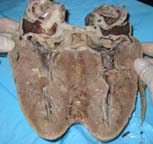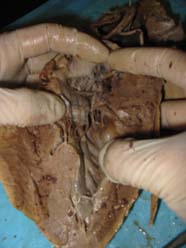
 |
Though Leonardo was most interested in the functions of the human heart, his most famous heart dissections were of pigs’ because they are very similar to human hearts and they are far easier to come by. Like Leonardo we obtained a pig’s heart, though ours was from a biological supplier rather than a butcher and ours was preserved for the purpose of dissection while the heart he dealt with probably began to rot soon after he obtained it. We tried to conduct our dissection with as much historical accuracy as possible so we used a similarly sized pig’s heart and comparable cutting and probing instruments. We studied Leonardo’s
sketches of his dissection in order to find what axes he cut on and how
he carried out his dissections. He sketches several different cutting
schemes, which makes it likely that he conducted more than one dissection,
but his most common axis was basically vertical. For this reason we approached
our dissection on a vertical axis first cutting a sliver, then halving
the heart, then quartering it. We tried to come as close to the viewpoints
in his sketches as we could. However, even with basic knowledge of how
the heart works and the approximate placement of chambers, valves, and
arteries, it was difficult to discern exactly what we were looking at.
We, and in all likelihood Leonardo as well, were left staring, slightly
perplexed, at a mass of muscle and connecting tubes. The dissection proved
to be an interesting if slightly confusing exercise. It is no wonder that
Leonardo was so intrigued by the heart or that he wanted to do more than
one dissection to address his still unanswered questions about the cardiovascular
system. |
 |
 |
 |
 |